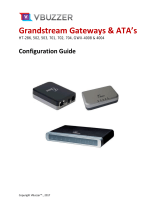
Grandstream Networks, Inc. HT-70X User Manual Page 2 of 35
Firmware Version 1.0.0.18 Last Updated: 03/2012
TABLE OF CONTENTS
HT70X User Manual
WELCOME.................................................................................................................................................... 4
SAFETY COMPLIANCES ................................................................................................................................. 4
WARRANTY .................................................................................................................................................. 4
CONNECT YOUR HT70X ............................................................................................................................. 5
EQUIPMENT PACKAGING ............................................................................................................................... 5
CONNECTING THE HT70X ............................................................................................................................ 5
PRODUCT OVERVIEW ................................................................................................................................ 9
SOFTWARE FEATURES OVERVIEW ................................................................................................................ 9
HARDWARE SPECIFICATION ........................................................................................................................ 10
BASIC OPERATIONS ................................................................................................................................ 11
UNDERSTANDING HT70X VOICE PROMPT ................................................................................................... 11
PLACING A PHONE CALL ............................................................................................................................. 12
CALL HOLD ................................................................................................................................................ 13
CALL WAITING ........................................................................................................................................... 13
CALL TRANSFER ........................................................................................................................................ 13
3-WAY CONFERENCING ............................................................................................................................. 14
FAX SUPPORT ........................................................................................................................................... 14
CALL FEATURES ...................................................................................................................................... 15
CONFIGURATION GUIDE ......................................................................................................................... 16
CONFIGURING THE HT70X THROUGH VOICE PROMPTS ................................................................................ 16
CONFIGURING THE HT70X VIA WEB BROWSER ........................................................................................... 16
IMPORTANT SETTINGS ................................................................................................................................ 17
Preferred VOCODER (Codec) ................................................................................................................ 18
ADVANCED USER CONFIGURATION ............................................................................................................. 20
SAVING THE CONFIGURATION CHANGES ..................................................................................................... 30
REBOOTING THE HT70X FROM REMOTE ..................................................................................................... 30
CONFIGURATION THROUGH A CENTRAL SERVER .......................................................................................... 31
SOFTWARE UPGRADE ............................................................................................................................. 32
FIRMWARE UPGRADE THROUGH TFTP/HTTP/HTTPS ................................................................................ 32
INSTRUCTIONS FOR UPLOAD FROM LOCAL DIRECTORY: ............................................................................... 32
INSTRUCTIONS FOR LOCAL FIRMWARE UPGRADE USING TFTP SERVER: ........................................................ 33
CONFIGURATION FILE DOWNLOAD .............................................................................................................. 33
FIRMWARE AND CONFIGURATION FILE PREFIX AND POSTFIX ........................................................................ 33
MANAGING FIRMWARE AND CONFIGURATION FILE DOWNLOAD ..................................................................... 33
RESTORE FACTORY DEFAULT SETTING .............................................................................................. 35
























